Guide for dating Acme Beer labels and Acme Breweriana
BREWERY GEMS ARTICLE:
Guide for dating Acme Beer labels and Acme Breweriana
![]()
This article is intended as a aid in dating breweriana, specifically for Acme collectibles from the period 1933 to 1953.
However, the following paragraph gives info that applies to beer labels of all brands of beer - not just Acme.
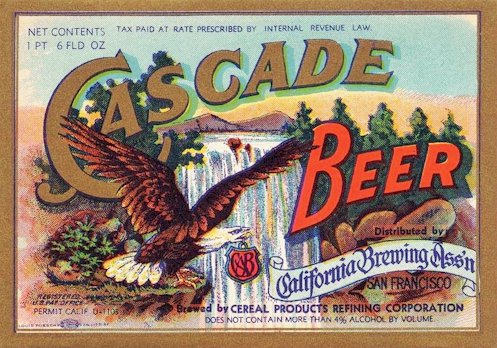 Beer labels provide clues as to age when they carry citations mandated by the Bureau of Internal Revenue.
From 1933 to 1950, labels were required to include
the statement: "Tax Paid at Rate Prescribed by Internal Revenue Law"
which was later shortened to: "Internal Revenue Tax Paid."
Beer labels provide clues as to age when they carry citations mandated by the Bureau of Internal Revenue.
From 1933 to 1950, labels were required to include
the statement: "Tax Paid at Rate Prescribed by Internal Revenue Law"
which was later shortened to: "Internal Revenue Tax Paid."
From April 1933 to Sept. 1935, all beer labels were required to include the U-Permit number which identified the brewery that produced the beer. This Cascade label states: "Permit Calif. U-1103" which is the number for Cereal Products Refining Corp.
Also from 1933 to 1935 was the requirement to state the alcohol content of the beer. When the Volstead Act was amended on April 7, 1933, beer could again be brewed, but not in excess of 3.2% by weight, or 4% by volume. It wasn't until the 21st Amendment was ratified on Dec. 5, 1933, that pre-Prohibition strength beer was legal. From the statement on the Cascade label: "Does Not Contain More than 4% Alcohol by Volume" suggests that this label was in use from April to December of 1933.
However, this particular label was for a "1 pt. 6 oz." or 22 oz. bottle, which was introduced in July of '33, so this label could only have been used from July to Dec. of 1933.
The Following is specifically for Acme, and illustrates the progression of their flagship, "Stein-girl" label after Prohibition (April 1933). For information on the pre-prohibition versions go to the Acme history page.
The 1st label used after Prohibition was a version of the 1924 stein-girl label (thumbnail right), with just the slight modification of replacing "A Delightful Beverage" with "Lager Beer."

|
1933
to 1935 - This U-Permit label states: "Does not
contain more than 3.2% alcohol by weight," which like the
label above suggests that it was used from April 1933 to
1935. But also, like the above label, it's for a "11/16 of a
quart" or 22 oz. bottle, which was introduced in July '33,
so the bottle dates from July '33 to
Dec. '33. This San Francisco label, without the "3.2% alcohol" statement was used from Dec. '33 to June '35 when the Los Angeles plant citation was added to the label. |
 |
1935 - Full strength beer was made legal in December 1933, and this label reads: "over 5½% alcohol by volume." Then on June 1, 1935 the Los Angeles branch brewery was opened, which is indicated on this label, and in August, 1935 the newly formed Federal Alcohol Administration mandated that alcohol strength can no longer be specified on beer labels. So this SF/LA label dates from only a two month period, June 1935 to Aug. 1935. |
 |
1935 to 1936 - The label at right, without the alcohol statement, was in use from August '35 until April 1936, when the "brewed by Cereal Products Refining Corp." was removed from the label (see above), and "Acme Breweries" replaced "California Brewing Assn." This was also for a 22 oz. bottle, a size that was available until June of '36. Acme's first canned beer was introduced in Jan. 1936, which was a more convient size to refrigerate and stack, which helped kill the 22 oz. bottle |
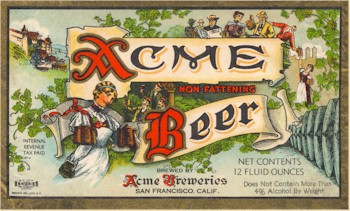 |
1936 to 1940 - The first major change in
the label took effect in August of '36 with the introduction of the
"stennie" bottle. The
background figures were repositioned and the stein girl moved to the left
to make room for one large "Beer" banner, dropping the word
"Lager" from the label. Also, "Acme Brewing Assn." was
replaced by "Acme Brewing Assn." in San Francisco, and "Acme
Brewing Co." in Los Angeles. This version also carried the notation: "Non-Fattening" in red, placed between "Acme" and "Beer". They were soon ordered to remove the claim from the label, but continued using it in their advertising. |
 |
1940 to 1946 - Further simplifications were made to the label's background graphics by removing the figures above the "Acme" marquee, and simplifing the font for the red, capital "B". |
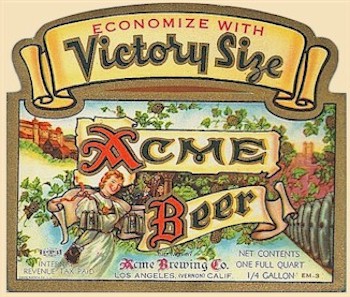 |
1942 to 1945 - Just four months into WWII, bottle caps
were being rationed and Acme promoted buying quarts to save caps.
Their slogan in print ads was: "Party Size for the Economy-Wise."
See the second 1942 ad below. Two months later, in June '42, they came out with this new label and the slogan: "Victory Size for the Economy-Wise" - which was placed on the label. Rationing continued awhile after the war, and in 1946 they came out with updated graphics and a new banner for the quart labels by replacing the word "Victory" with "Party" - see label below. |
 |
1946 to 1947 - The label's background figures, between the "Acme" and "Beer" banners, are now wearing contemporary clothing. Labels for the smaller size bottles didn't have any banners at the top like this quart size. |
 |
1948 to 1950 - The small, background figures are now gone and the banner with "Beer" is shorter
and smaller, plus the word "Beer" is now all in black and
in a smaller font than "Acme". This was Acme's last "Stein Girl" label. |
 |
1950 to 1954 - In 1950 the "Stein Girl" label was dropped
in favor of the label (far left) with a simplified and modernized font.
Then in Oct. 1952, the label was changed again with "Acme" reduced in size, emphasizing "Gold Label." But the label changes didn't help with sales. Fourteen months later the company was sold. |
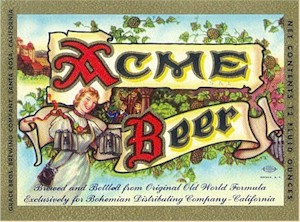 |
1958 - The Acme Brewing Co. had been sold in Jan. 1954, but the new owners, Liebmann Breweries, didn't use the Acme brand. However, when Liebmann closed the brewery in 1958, Acme's LA business partner, Bohemian Distributing, purchased the brand. They then contracted with Grace Bros. of Santa Rosa to produce Acme Beer. They reprised the 1940 version of the Stein Girl label, but in a size comparable to the 1948 label. |
ORGANIZATION SYMBOLS -
From 1933 to 1961 there were four symbols in use that often appeared
in display ads, prints and posters. These were not exclusive
to Acme.
The thumnail image at right shows an Acme fan with the the NRA logo,
but also the slogan: "America's Favorite" which was used only in
1933.
The ad at right displays the UBIF logo, and a slogan that was used for
the 1939 advertising campaign.
In general, Acme adopted an ad campaign at the beginning of a
calendar year and stayed with it the entire year. But this was not
always the case. Sometimes there was more than one campaign for a
given year or one that was only used breifly. Additionally, there
were some that were repeated, and in the case of the non-fattening
claim - lasted almost as long as the company.
The card at right uses "The Prince of Pilsner" as well as "The
Favorite" - suggesting an early 1935 printing.
Also in '38, the bottle label for Englishtown Ale was changed.
They also dropped "Dietically Non-Fattening" from the can, but other
than that the can's graphics were unchanged until 1940.
The "High I.Q." campaign continued and the "Dietically Non
Fattening" tag-line returned (at right). Also
at this time, Acme adopted Albert Staehle's bear cub as an
element in its advertising. Both are evident in this Thanksging
poster - far right.
An additional tag line
used was "Fine Beers since 1860" which inferred a long history
of
brewing but actually referred to two company officials whos
ancestors had also been brewers in
California. This tag line was used on coasters (right), ads, and
even labels.
Spring of 1947 also saw the return of Acme's
Bock Beer after a four year absence (in bottles only).
Additionally, last years slogan was modified to say: "The
Finest Tasting Acme ever brewed" - as seen in this
die-cut, cardboard sign (right).
Copyright © by BreweryGems ~ All Rights Reserved.
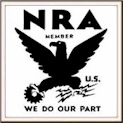
 1933
to 1935 The National Industrial Recovery
Act was passed in 1933 to regulate industry in an attempt to raise
prices and stimulate economic recovery after the Depression.
1933
to 1935 The National Industrial Recovery
Act was passed in 1933 to regulate industry in an attempt to raise
prices and stimulate economic recovery after the Depression.
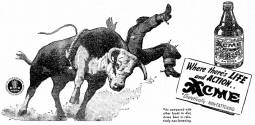 1936
to 1942
The United Brewers Industrial Foundation (UBIF) was a
self-regulating organization for member breweries.
1936
to 1942
The United Brewers Industrial Foundation (UBIF) was a
self-regulating organization for member breweries.
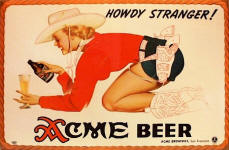 1942
to 1944
The Brewing Industry Foundation (BIF) was a
reorganization of the UBIF, above.
1942
to 1944
The Brewing Industry Foundation (BIF) was a
reorganization of the UBIF, above.
The image on the tin sign at right was painted by Petty for Acme in
1943, and displays the BIF logo in the lower right corner.

 1945
to 1961 The United States Brewers Foundation (USBF)
was formed through the merger of The United States Brewers
Association and the above BIF. The new organization became a public
relations arm of the the brewing indusrty.
1945
to 1961 The United States Brewers Foundation (USBF)
was formed through the merger of The United States Brewers
Association and the above BIF. The new organization became a public
relations arm of the the brewing indusrty.
The ad at right displays the USBF logo, and a slogan that was
still being used in
the 1946 advertising campaign. Also, the bottle label
was introduced in Jan. 1946.
While mandated information on labels, the label graphics,
and the use of organizational symbols all provide dating
information, Acme's advertising campaigns can narrow the time frame
in dating their breweriana.
ACME AD CAMPAIGNS

 1933 - This Sept. 1933 ad leads with the Non Fattening
claim and also uses the slogan, "America's Favorite."
1933 - This Sept. 1933 ad leads with the Non Fattening
claim and also uses the slogan, "America's Favorite."
The convex glass Acme sign at right also has "America's Favorite"
which dates the piece at 1933.
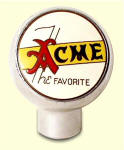
 1934 -
Acme must have concluded that its beer couldn't be "America's
Favorite" since they were just a West Coast brand, so they modified
the slogan for their print ads to "The Favorite."
1934 -
Acme must have concluded that its beer couldn't be "America's
Favorite" since they were just a West Coast brand, so they modified
the slogan for their print ads to "The Favorite."
The phrase was also used on this ball tap knob, ca. 1934-35.
 1935
- This ad from Sept. 1935 continues to use the tagline "Non
Fattening" and adds the Slogan: "Prince of Pilsner" for the 1935 ad
campaign.
1935
- This ad from Sept. 1935 continues to use the tagline "Non
Fattening" and adds the Slogan: "Prince of Pilsner" for the 1935 ad
campaign.

 1936
- Acme introduced two new containers and an Ale, so the marketing
focused on that rather than any new slogans. But they continued with
the "non fattening" tagline.
1936
- Acme introduced two new containers and an Ale, so the marketing
focused on that rather than any new slogans. But they continued with
the "non fattening" tagline.
This ad (left) from January '36 introduces Acme Beer in cans -
called a Keglet.

The ad
(far right) is from August '36, and introduces Acme Beer in
"steinies."
The ad (near right) introducing Acme's Englishtown
Ale appeared in Oct. '36.

 1937
-
In March '37 the Federal Trade Commission ruled that Acme
could not claim that their beer was non-fattening without supporting
verbage. So Acme added the qualifier "dietetically." The new
claim was added to their labels in April '37 - as can be seen on
this steinie (left).
1937
-
In March '37 the Federal Trade Commission ruled that Acme
could not claim that their beer was non-fattening without supporting
verbage. So Acme added the qualifier "dietetically." The new
claim was added to their labels in April '37 - as can be seen on
this steinie (left).

In August '37 Acme edited the can to read "Dietically Non-Fattening"
as show in the ad at right.
Another item that dates from
1937 is this Acme sham style glass. The only clue is the Old English
style font used for the capital "B"
- which, when compared to the '37 label above, indicates the glass
dates from 1937 to 1940.
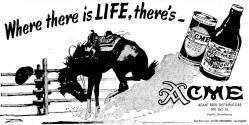

 1938 -
This year's campaign slogan was "Where there
is LIFE...there's Acme!"
The glass at right has the same image as the ad at left, dating the
glass to 1938. The slogan was used on posters as well - far right.
1938 -
This year's campaign slogan was "Where there
is LIFE...there's Acme!"
The glass at right has the same image as the ad at left, dating the
glass to 1938. The slogan was used on posters as well - far right.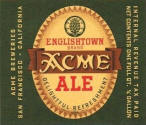

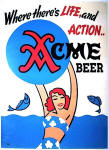 1939
- This July 1939 ad shows that this year's campaign merely added
"Action" to the slogan "Where there is Life.."
1939
- This July 1939 ad shows that this year's campaign merely added
"Action" to the slogan "Where there is Life.."
The poster at right also displays the new slogan.

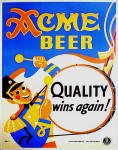 1940
- The slogan for the 1940 campagin was "Quality Wins Again!" and
was used on numerous posters and other print media.
1940
- The slogan for the 1940 campagin was "Quality Wins Again!" and
was used on numerous posters and other print media.
A
good bit of 1940 advertising was used to promote Acme's new can (ad
at left) from
the
Pacific Can Co. called "Marvel-Lined."
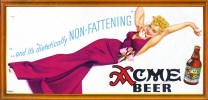
1940 was also the
year Acme introduced the first of three Petty girls, continuing with
the Non-Fattening tag-line.

 1941
- The slogan for 1941 was "They all
say..Yes!" This fan (right) uses the slogan, and the same
image also appears on a cardboard, die-cut sign - with
the slogan.
1941
- The slogan for 1941 was "They all
say..Yes!" This fan (right) uses the slogan, and the same
image also appears on a cardboard, die-cut sign - with
the slogan.
 This year they
also adopted the slogan for their Englishtown Ale - "There's a pip of
a NIP in every sip!"
This year they
also adopted the slogan for their Englishtown Ale - "There's a pip of
a NIP in every sip!"
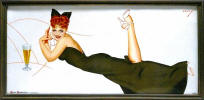
This was also when the second
pin-up girl by George Petty was introduced.

 1942 -
This year was the introduction
of the slogan: "the beer with the high I.Q.(It Quenches!)"
1942 -
This year was the introduction
of the slogan: "the beer with the high I.Q.(It Quenches!)"
This war time slogan: " You'll go for Acme Beer" was only
used in '42.
 With
the onset of WWII, the rationing of bottle caps prompted Acme to
promote buying quarts so as to minimize their use. This April
'42 ad depicts a quart size bottle without a special label, and
along the bottom of the ad is the slogan: "Party Size for the
Economy-Wise!"
With
the onset of WWII, the rationing of bottle caps prompted Acme to
promote buying quarts so as to minimize their use. This April
'42 ad depicts a quart size bottle without a special label, and
along the bottom of the ad is the slogan: "Party Size for the
Economy-Wise!"
In June, Acme changed the quart label by
adding a banner along the top stating: "Economize with Victory
size."

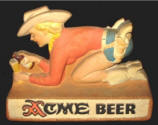 1943
- Acme's limited advertising during the war resulted in a repetition
of the "High I.Q." campaign. Also in '43, was the introduction of
the third Petty girl - the popular "cowgirl." They used her image in posters,
tin signs, a tray, and even this back-bar figure.
1943
- Acme's limited advertising during the war resulted in a repetition
of the "High I.Q." campaign. Also in '43, was the introduction of
the third Petty girl - the popular "cowgirl." They used her image in posters,
tin signs, a tray, and even this back-bar figure.
Additionally, rationing cut
production levels, and The U.S. Dept. of Agriculture required
that breweries allocate 15% of their production to the military.
 1944-45
-
Again, Acme just continued with
the "High I.Q." campaign.
1944-45
-
Again, Acme just continued with
the "High I.Q." campaign. The image in the ad at left is a pin-up by Varga
and gives a nod to the Victory gardens. The full size print at right
shows the full image.
The image in the ad at left is a pin-up by Varga
and gives a nod to the Victory gardens. The full size print at right
shows the full image.
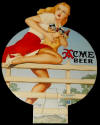
Also included is another
pin-up from Varga for 1944, showing a gal climbing a fence
carrying a bag of Acme beer.
Due to the increase in war-time restrictions, metal was
limited to canned beer for servicmen. Luckily for collectors
some of these olive-drab beer cans
found their way home after the war. Even though the war
ended in Sept. 1945, shortages and rationing continued into
1947.


_small.jpg) 1946 -
Continuing government controls mandated that beer production be reduced
30% until shortages were overcome.
1946 -
Continuing government controls mandated that beer production be reduced
30% until shortages were overcome.

 1947
- By '47 war time restrictions and shortages were gone and Acme
introduced a number of changes. The slogan: "The Age of Acme" was
introduced, and can be seen on the ad and coaster (right) announcing the return of the beer
can for the general public - and with a new label
1947
- By '47 war time restrictions and shortages were gone and Acme
introduced a number of changes. The slogan: "The Age of Acme" was
introduced, and can be seen on the ad and coaster (right) announcing the return of the beer
can for the general public - and with a new label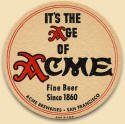 .
Then in June they introduced their one-way bottle (at left).
.
Then in June they introduced their one-way bottle (at left).
 Another slogan adopted in '47 is "The Finest Acme ever
brewed.." and in one case was used with a Varga pin-up (far
right).
Another slogan adopted in '47 is "The Finest Acme ever
brewed.." and in one case was used with a Varga pin-up (far
right).

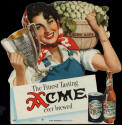 1948
- The "Dietetically Non-Fattening" tag-line remains in
effect, as does last year's "Fine Beers since 1860" as can be
seen on this ad (left).
1948
- The "Dietetically Non-Fattening" tag-line remains in
effect, as does last year's "Fine Beers since 1860" as can be
seen on this ad (left). 
For '48, Acme used a new Varga pin-up for their Christmas
Greeting card. The same image appeared widely in their advertising.

 1949 -
Acme revives the "High I.Q." slogan, but now it's "Higher"
and the I.Q. stands for "It's Slow Brewed
Quality!" instead of "It
Quenches!"
1949 -
Acme revives the "High I.Q." slogan, but now it's "Higher"
and the I.Q. stands for "It's Slow Brewed
Quality!" instead of "It
Quenches!"
 Then
in Oct. '49 they did a blind tasting and the results were
expressed as "Acme is prefered six to four, ask for The Champ."
They came out with a display figure of "The Champ"
(far right)and used his
cartoon depiction in their ads.
Then
in Oct. '49 they did a blind tasting and the results were
expressed as "Acme is prefered six to four, ask for The Champ."
They came out with a display figure of "The Champ"
(far right)and used his
cartoon depiction in their ads.

They also gave out these
dice with only sixes on one, and fours on the other - plus "Acme
Wins."

 1950
- They continued with the "Acme Wins 6 to 4" slogan until the
May release of their new can of Acme, Light Dry Beer. The can
was quite a departure from the old can in that it was decorated
to look like a glass of beer (far right), and as part of the
1950
- They continued with the "Acme Wins 6 to 4" slogan until the
May release of their new can of Acme, Light Dry Beer. The can
was quite a departure from the old can in that it was decorated
to look like a glass of beer (far right), and as part of the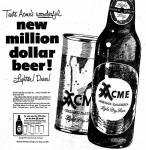 change they chose a
new font for Acme's iconic, red "A."
change they chose a
new font for Acme's iconic, red "A."
In Oct. '50, they made a bold
move and changed the brand to "Acme Gold Label" - as shown
in the ad (right).
shown
in the ad (right).
Another can was introduced in '50. For
the first time, Acme Bock was released in a can, only to be changed
the following year.
 1951
- This was the third year of a downturn in advertising, and a
decrease in
promotional items. This year's
new campaign carried the slogan: "gimme Gold Label." They also
offered a 7oz. size
bottle they called a "nugget" that sold for 20¢.
1951
- This was the third year of a downturn in advertising, and a
decrease in
promotional items. This year's
new campaign carried the slogan: "gimme Gold Label." They also
offered a 7oz. size
bottle they called a "nugget" that sold for 20¢.![]()
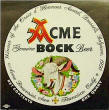 After winning an award for their Bock beer at an Expo in
Brussels, Acme introduced a new Bock label and
can to tout the award.
After winning an award for their Bock beer at an Expo in
Brussels, Acme introduced a new Bock label and
can to tout the award.
This footed, pilsner glass
was one of the few collectibles distributed in '51.


 1952
- With slumping sales, Acme tried an entirely new approach to
their advertising. Instead of going after the female shoppers,
with claims of non-fattening beer, they went for the men with a
new product - Bull Dog Beer.
1952
- With slumping sales, Acme tried an entirely new approach to
their advertising. Instead of going after the female shoppers,
with claims of non-fattening beer, they went for the men with a
new product - Bull Dog Beer.
Encouraged by its acceptance
they soon introduced a Bull Dog Ale.
To prop up their Gold
Label brand, in Oct. '52, Acme changed the label by de-emphasing
"Acme" and putting all the emphasis on "Gold Label." They also changed
the design of the can from the "glass of beer" to match the
bottle label, as shown in the ad far right).
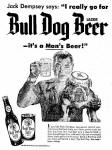
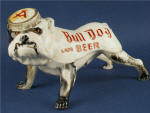 1953 - Acme appeared to be in
decline and the Bull Dog brand was all that was doing much. In a
last ditch attempt to get the public's attention Acme hired
ex-world heavy weight champion, Jack Dempsey to promote the
brand. The results were satsifactory but not enough for the
company to carry on.
1953 - Acme appeared to be in
decline and the Bull Dog brand was all that was doing much. In a
last ditch attempt to get the public's attention Acme hired
ex-world heavy weight champion, Jack Dempsey to promote the
brand. The results were satsifactory but not enough for the
company to carry on.
In late December '53, Liebmann
Breweries of NY offered five million dollars for Acme's SF & LA
breweries - and the offer was accepted.
The SF plant
became the California Brewing Co. (SF branch of Liebmann Breweries,
NY) and in March of '54, they introduced Bull Dog Stout. The
rights to the Acme brand was retained by Bohemian Distributing
and in 1959 they contracted with Grace Bros. to re-introdued
Acme Beer.
MISCELLANEOUS ACME BREWERIANA
Acme
distributed a great many lighted signs over their 20 year run.
Unfortunately it's difficult to assign a date to these items
since there's no clues other than the style of lettering, and
Acme didn't change that much.
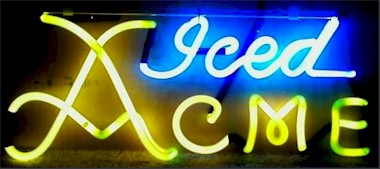
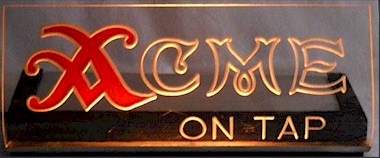

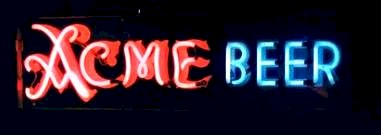
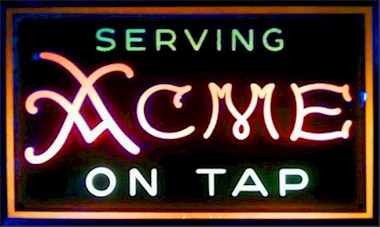


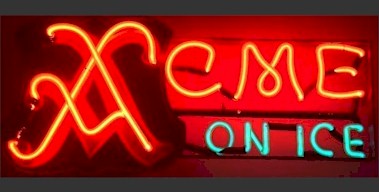
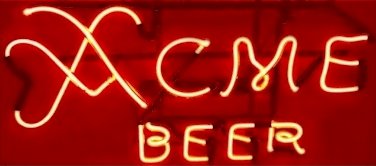
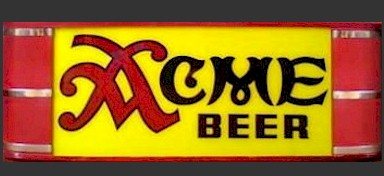
Tap knobs are much like these lighted signs, in that
they don't provide much information. However, with the first
knob you have the slogan "The Favorite" - which has already been
identified as a 1934-35 slogan. The next two don't reveal any
clues, but the last knob has the modernized font that was
adopted in 1950.

Now perhaps you can help me. Here are three Acme mugs
made by J.J. Fulop - Calif. and I know little about them. It
was suggested that these were made for the Sequoia Lodge - the
hospitality center for Bohemian Dist. Co. and the Acme brewery,
and I've just recently had that confirmed by a descendant of one
of Bohemian's founders.
There are just these three basic designs, but
they're hand painted and were done in many different color schemes.
I haven't been able to find anything on the maker, J.J. Fulop. Can
anyone help with this?

If
you have any Acme items to sell or trade -
please get in touch. And for more on Acme go to the
Acme history page.
Article by
For any comments, additions, or corrections please
contact me:![]()